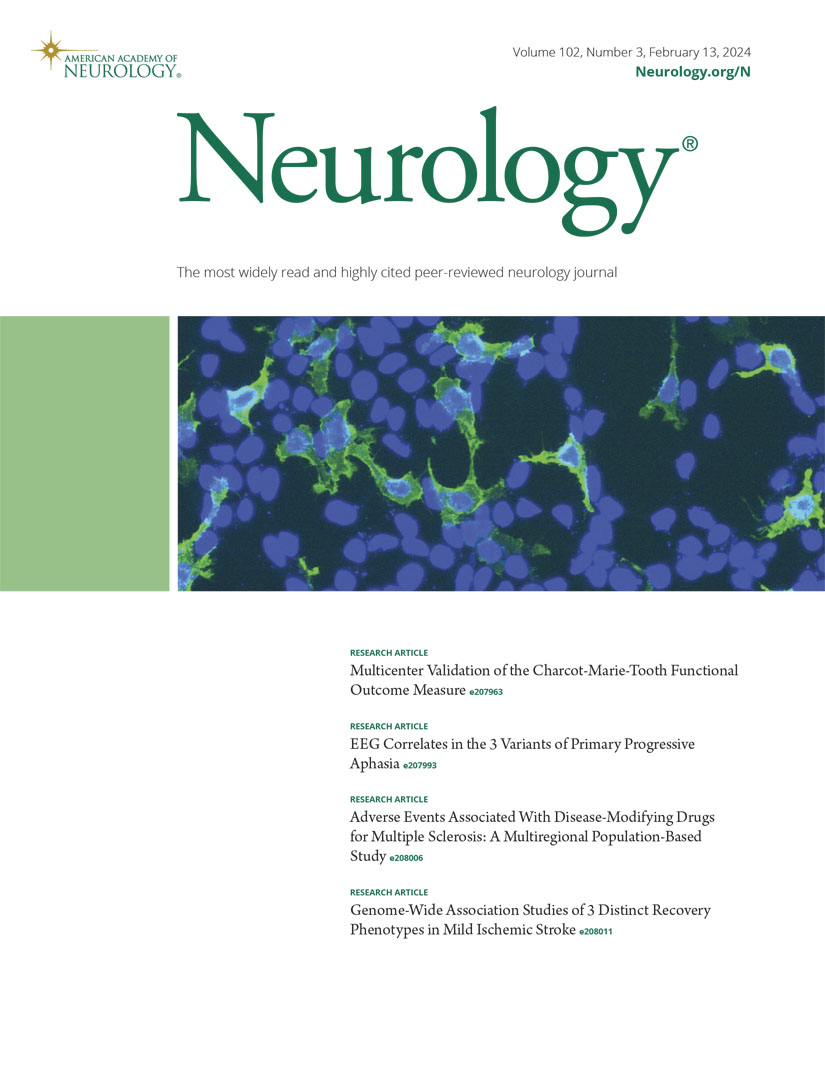Association of Hypoxemia Due to Obstructive Sleep Apnea With White Matter Hyperintensities and Temporal Lobe Changes in Older Adults.
IF 7.7
1区 医学
Q1 CLINICAL NEUROLOGY
引用次数: 0
Abstract
BACKGROUND AND OBJECTIVES Cerebral small vessel disease (CSVD) is a leading cause of cognitive decline and functional loss in older adults. Obstructive sleep apnea (OSA) is common in older adults, can increase cerebrovascular disease risk, and is linked to medial temporal lobe (MTL) degeneration and cognitive impairment. However, the interaction between OSA features and CSVD burden and their combined effect on MTL structure and function are not well understood. This study tested the hypothesis that CSVD burden is a candidate mechanism linking OSA to MTL degeneration and impaired memory in older adults. METHODS Cognitively unimpaired older adults from the Biomarker Exploration in Aging, Cognition, and Neurodegeneration cohort were recruited for an observational, in-lab overnight polysomnography (PSG) study with emotional mnemonic discrimination ability assessed before and after sleep. Participants had no neurologic or psychiatric disorders and were not on sleep-affecting medications. PSG-derived OSA variables included apnea-hypopnea index (AHI), total arousal index, and minimum SpO2. MRI was used to assess global and lobar white matter hyperintensity (WMH) volumes and MTL structure (hippocampal volume; entorhinal cortex [ERC] thickness) at an earlier time point. Regressions were implemented while adjusting for age, sex, and concurrent use of antihyperlipidemic and/or antihypertensive medication. Minimum SpO2 was transformed into a Hypoxemia Severity Index for normality, in which lower SpO2 values indicated more severe hypoxemia. RESULTS Thirty-seven older adults were included in the study (age 72.5 ± 5.6 years, 23 women, AHI = 13.8 ± 18.0 [range 0-80]). Hypoxemia measures significantly predicted global WMH volume (bminSpO2 = 0.141 [0.001-0.282], bduration <90% = 0.008 [0.000-0.016]). This relationship was driven by hypoxemia severity during REM sleep (bREMminSpO2 = 0.143 [0.003-0.284]), which also predicted frontal (bREMminSpO2 = 0.101 [0.004-0.198]) and parietal (bREMminSpO2 = 0.121 [0.024-0.219]) WMH burden. Greater frontal WMH burden indirectly mediated the relationship between REM sleep hypoxemia and ERC thickness (indirect effect = -0.043, 95% CI -0.1174 to -0.00015). Reduced ERC thickness was, in turn, associated with worse overnight mnemonic discrimination ability (bleftERCthickness = 0.112 [0.014-0.211]). DISCUSSION These findings identify CSVD as a candidate mechanism linking OSA-related hypoxemia to MTL degeneration and impaired sleep-dependent memory in older adults, specifically implicating hypoxic events during REM sleep.阻塞性睡眠呼吸暂停引起的低氧血症与老年人白质高强度和颞叶变化的关系。
背景与目的脑血管病(CSVD)是老年人认知能力下降和功能丧失的主要原因。阻塞性睡眠呼吸暂停(OSA)在老年人中很常见,可增加脑血管疾病的风险,并与内侧颞叶(MTL)变性和认知障碍有关。然而,OSA特征与CSVD负担之间的相互作用及其对MTL结构和功能的综合影响尚不清楚。本研究验证了CSVD负担是将OSA与老年人MTL变性和记忆受损联系起来的候选机制。方法从衰老、认知和神经变性生物标志物探索队列中招募认知功能正常的老年人,进行一项观察性的实验室夜间多导睡眠图(PSG)研究,评估睡眠前后的情绪记忆辨别能力。参与者没有神经或精神疾病,也没有服用影响睡眠的药物。psg衍生的OSA变量包括呼吸暂停低通气指数(AHI)、总唤醒指数和最低SpO2。MRI用于评估全脑和脑叶白质高强度(WMH)体积和MTL结构(海马体积;内嗅皮质[ERC]厚度)在较早时间点。在调整年龄、性别和同时使用抗高脂血症和/或抗高血压药物的情况下进行回归。最低SpO2转化为正常低氧血症严重程度指数,低SpO2值表示低氧血症更严重。结果37例老年人纳入研究(年龄72.5±5.6岁,女性23例,AHI = 13.8±18.0[范围0-80])。低氧血症可显著预测全球WMH体积(bminSpO2 = 0.141 [0.001-0.282], bduration <90% = 0.008[0.000-0.016])。快速眼动睡眠期间低氧血症严重程度(bREMminSpO2 = 0.143[0.003-0.284])推动了这一关系,该关系也预测了额叶(bREMminSpO2 = 0.101[0.004-0.198])和顶叶(bREMminSpO2 = 0.121 [0.024-0.219]) WMH负担。额部WMH负担加重间接介导了REM睡眠低氧血症与ERC厚度之间的关系(间接效应= -0.043,95% CI -0.1174 ~ -0.00015)。ERC厚度降低反过来又与较差的隔夜助记辨别能力相关(bleftERCthickness = 0.112[0.014-0.211])。这些研究结果表明,CSVD是将osa相关低氧血症与老年人MTL变性和睡眠依赖性记忆受损联系起来的候选机制,特别是与REM睡眠期间的缺氧事件有关。
本文章由计算机程序翻译,如有差异,请以英文原文为准。
求助全文
约1分钟内获得全文
求助全文
来源期刊

Neurology
医学-临床神经学
CiteScore
12.20
自引率
4.00%
发文量
1973
审稿时长
2-3 weeks
期刊介绍:
Neurology, the official journal of the American Academy of Neurology, aspires to be the premier peer-reviewed journal for clinical neurology research. Its mission is to publish exceptional peer-reviewed original research articles, editorials, and reviews to improve patient care, education, clinical research, and professionalism in neurology.
As the leading clinical neurology journal worldwide, Neurology targets physicians specializing in nervous system diseases and conditions. It aims to advance the field by presenting new basic and clinical research that influences neurological practice. The journal is a leading source of cutting-edge, peer-reviewed information for the neurology community worldwide. Editorial content includes Research, Clinical/Scientific Notes, Views, Historical Neurology, NeuroImages, Humanities, Letters, and position papers from the American Academy of Neurology. The online version is considered the definitive version, encompassing all available content.
Neurology is indexed in prestigious databases such as MEDLINE/PubMed, Embase, Scopus, Biological Abstracts®, PsycINFO®, Current Contents®, Web of Science®, CrossRef, and Google Scholar.
 求助内容:
求助内容: 应助结果提醒方式:
应助结果提醒方式:


